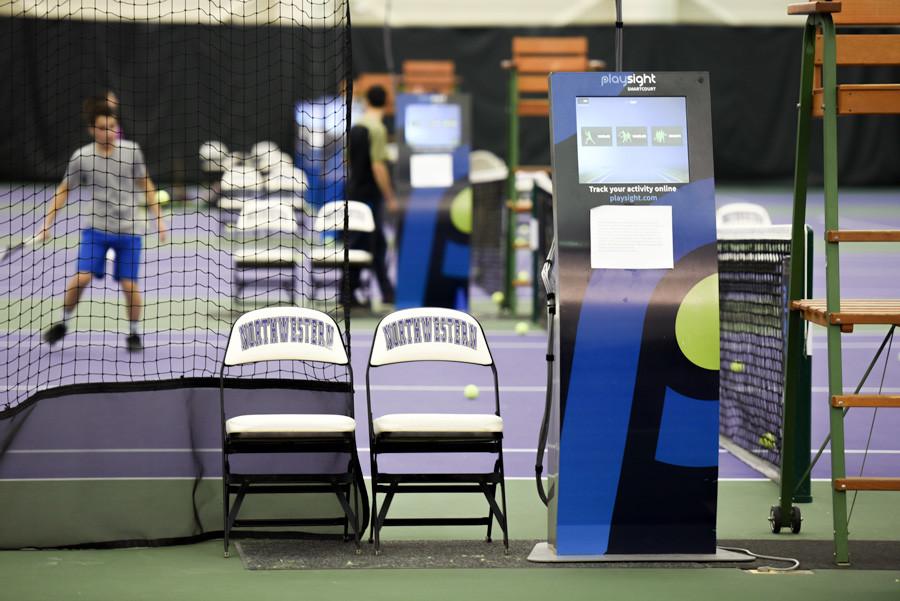New PlaySight system a hit for Northwestern tennis programs
Zack Laurence/Daily Senior Staffer
A PlaySight kiosk sits beside a tennis court. The data collection system has greatly benefitted the men’s and women’s tennis teams so far this season.
February 8, 2016
A new dimension has been added to Northwestern’s tennis programs this year.
Cameras and courtside kiosks that provide information on the locations, speeds and results of every stroke have been installed on the courts for the 2015-16 season. The new technology, created by the company PlaySight Interactive, allows players and coaches to examine their matches and practices more closely, gathering data which they used to estimate.
The instantaneous collection of film has allowed players to review their strokes and make immediate adjustments while their memories are still fresh. Women’s tennis coach Claire Pollard said PlaySight has already changed the way the team approaches its practices and matches.
“It’s really a big benefit in matches,” Pollard said. “Analyzing the statistics in the matches after is really where I see a huge benefit.”
NU is one of only 12 college tennis programs in the country to have the PlaySight system installed and was first in the Big Ten to do so.
The system came to NU by way of Josh Graves (Weinberg ‘12), a former Wildcat tennis player who collected back-to-back second-team All-Big Ten honors as an upperclassman. Graves was working for eBay and coaching tennis in New York City on the side when he saw PlaySight being installed on the courts where he taught.
“I was just a hitting partner in a lesson one day, and this technology was being installed on that court,” Graves said. “When I saw it I got really excited about the technology since it was obviously something I had never seen before, and I had grown up playing tennis my whole life.”
Graves went on to get a job at PlaySight’s United States office. He thought the instant analysis would have great benefits for his alma mater’s tennis program and said he pitched the system to men’s tennis coach Arvid Swan.
The coach agreed that since the data is easily accessible courtside, on computers and on mobile devices, his players can evaluate their play more closely.
“In practice sets and matches we get statistics from it right away, and then players can see their performance immediately,” Swan said.
The technology includes six cameras placed around each court that work together to track the location of the ball in three-dimensional space as well as its velocity. PlaySight uses these observations to compile statistics previously only accessible to professionals, such as net clearance, unforced errors and net points won.
“They have so much variety of what you can look at in your game,” senior women’s player Alicia Barnett said. “Whether it’s the depth of the ball or the spin, or height over the net or anything, the variety in what you can get from watching is incredible.”
The videos of matches and practices allow the Cats’ coaches to go more in-depth with their film study thanks to PlaySight’s visual aids. For instance, junior men’s player Konrad Zieba said he used the system’s video review to improve his serve.
“You can see video of yourself serving so if there are some technical adjustments you need to make, you can make those changes,” Zieba said. “I’ve been working on my serve a lot, trying to get a higher percentage (of balls) in.”
When the system is turned on, Graves said coaches can follow every shot players hit and players become more aware of the importance of each stroke in practice, fundamentally changing the way players prepare.
“Because the system is able to track where the ball is in the air, it’s able to set up target zones on the court,” Graves said. “Players are really mindful during practice being able to focus on every single ball. Every ball counts now, they’re accountable for what they’re doing in practice.”
The cameras also have allowed NU to provide a live stream of every match on all six courts at the Combe Tennis Center, something coaches and players said they think could help generate fan interest as well as allow alumni to follow the team more closely.
Recruits are also able to watch matches from home and get a feel for the environment at NU’s matches, Graves said. He believes potential recruits would be interested in attending a program that has access to the advanced analysis.
Although PlaySight has not been installed on the outdoor courts and plans are in place to expand the program there, players and coaches have been able to quickly splice together videos of their play by category such as forehand winners, aces and net points. With all of this new technology available, the teams are still tinkering with how best to implement the system and take full advantage of its possibilities.
“There’s so many different ways to use it, we’re still kind of experimenting with it,” Swan said.
Email: [email protected]
Twitter: @benjyapelbaum


